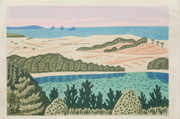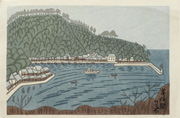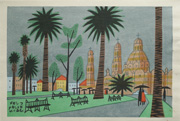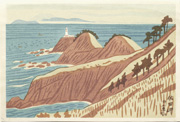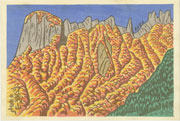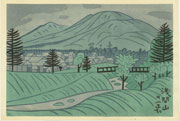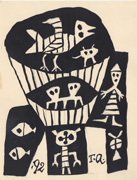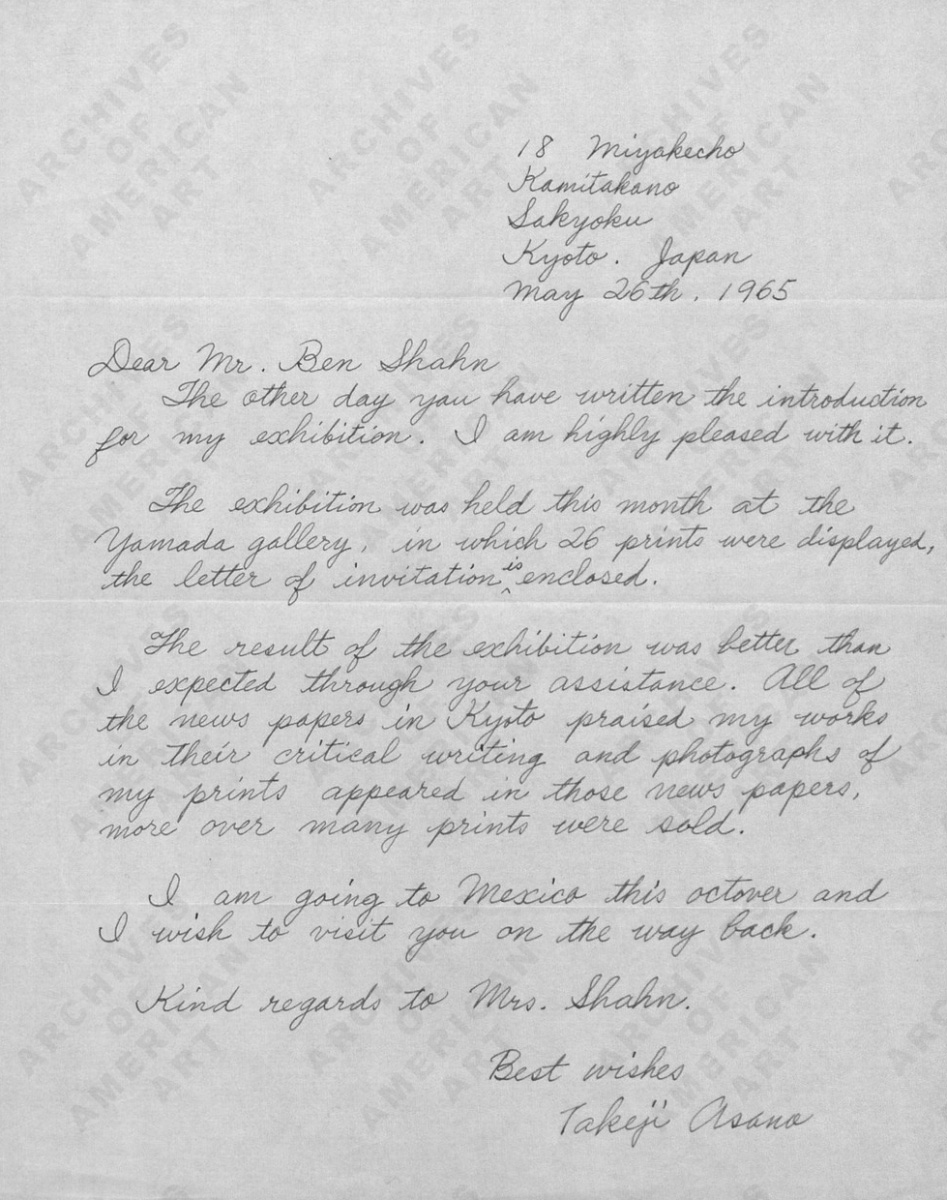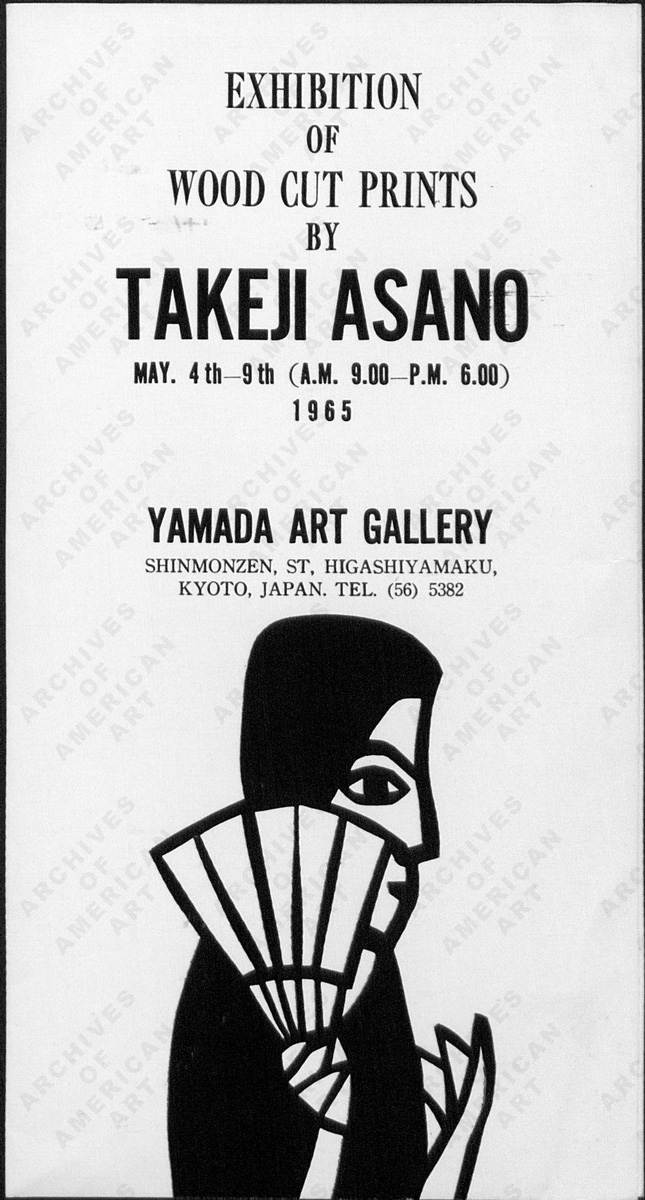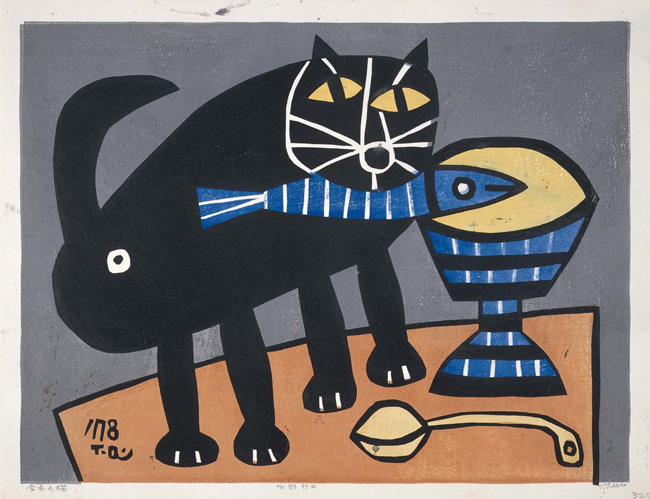Prints in Collection
| Distant View of Shijo in the Early Morning, 1931 IHL Cat. #718 | Moonlit Night at the Museum, 1932 IHL Cat. #717 | View Inside [Kyōto] Gyoen, 1934 IHL Cat. #2373 |
Bird, Fish and Haniwa-like Figures, 1992
IHL Cat. #2299
Biographical Data
Biography
Asano Takeji 浅野竹二 (1900-1999)Sources: Guide to Modern Japanese Woodblock Prints: 1900-1975, Helen Merritt, University of Hawaii Press, 1992, p. 12; Japanese Wood-block Prints, Shizuya Fujikake, Japan Travel Bureau, 1938 revised 1949, p. 190 and as footnoted.
Asano Takeji was one of many cross-over artists who worked in both the shin hanga (new prints) and sōsaku hanga (creative prints) styles. Born in Kyoto in 1900, he graduated from the Kyoto City School of Fine Arts and Crafts in 1919 and the Kyoto Municipal College of Painting in 1923. He first learned Western oil painting and then turned to Japanese-style painting under Tsuchida Bakusen (1887-1936). In 1928, he became interested in woodblock printing through a course offered at Gasendo in Kyoto, by Hiratsuka Un'ichi (1895-1997), one of the founders of the sōsaku hanga movement. He was active in the formation of the Kyoto Sōsaku-Hangakai (Kyoto Creative Print Society) in 1929 along with Tokuriki Tomikichirō (1902-2000), Asada Benji (1899-1984), Kawai Unosuke (1889-1968), and others. In 1930, he participated with Tokuriki and Asada in creating the series Creative Prints of Twelve Months in New Kyoto (Sōsaku-hanga shin Kyoto junikagetsu) published by Uchida Publishing. In the early 1930s he contributed to the magazine Taishu hanga (Popular Prints), published by Kyoto Sōsaku-Hangakai. Also in the early-30s he worked on a self-carved and self-printed set of views of the Kyoto area, two designs of which are represented in this collection. In 1947, he created the self-carved, self-printed series Noted Views in the Kyoto-Osaka Area (Kinki meisho fukei). Starting in the 1950s, Asano designed a large number of shin hanga style prints for the Unsōdō Publishing company, which continue to be printed to this day. He was an associate member of Nihon Hanga Kyokai from 1955-1960. He became friends with the American artist Ben Shahn (1898-1969), during Shahn’s visit to Japan in 1964, and continued that friendship until Shahn's death.
May 1965 letter from Asada to the American artist Ben Shahn
click on image to enlarge
Archives of American Art
Archives of American Art
In the 1960s, Asano created a number of print series of scenic views (meisho-e) from various regions of Japan, including Hokkaidō, Kyūshū, Jōshin'etsu, San'in, Seto Inland Sea and Shikoku. Many of the series' title employ the phrase "Here and There" in their titles seen written in kanji as either 所々 or 散見. After his return from his extensive tour of Mexico, U.S.A., Spain, Italy, Greece, and Turkey in 1965 Asano created a ten print series titled Here and There in the West (西洋所々 Seiyō tokorodokoro), which included this collection's print Mexico City, Mexico (IHL Cat. #966.) While in Mexico City he held a one-artist exhibition.
His late prints from the 1970s and 1980s are simple, seemingly naïve, humorous, and signed T.A. preceded by an apostrophe and the year. (See "Artist Signatures and Seals" below.)
Noted for his carving skills, Takeji taught the art of woodblock carving and printing well into his 90s. According to one of his students, Fumio Machida, he would tell his students, “Don’t complicate your drawing. Eliminate all unnecessary things but leave the essence.”1 Further reminiscing, Machida goes on to say:
| After his wife passed away, we students often visited his house in order to share his loneliness, but it usually turned out that it was us who received much encouragement from him. He didn’t have a particular studio space, his living room was the studio. There was also a guest room attached to a sunny veranda where we all would sit and enjoyed listening to the telling of his younger days’ stories about going sketching to the Tohoku and Kanto areas, and to Sado Island, and about his experiences in Hokkaido when he was teaching at a woman’s school in Sapporo. Asano retired from the class, if I remember correctly, when he was 97 because he found it harder to walk. However, he continued to paint with gouache at home and we used to see a large pile of sketchbooks on his desk. He was painting 5-6 pieces a day.2 |
1 KIWA News No. 3, November 2000, Kyoto International Woodprint Association, p. 6.
2 Ibid, p. 11.
3 Ibid, p. 6.
Recent Exhibitions
Source: The Japan Times, Culture Art https://www.japantimes.co.jp/culture/2020/01/22/arts/openings-outside-tokyo/asano-takeji-daily-life-prints/#.XtGM0zpKiUk
'Asano Takeji: Daily Life With Prints'
ITAMI CITY MUSEUM OF ART
Takeji Asano's "Cat on the table" (1978)
Itami City Museum of Art; 2-5-20 Miyanomae, Itami, Hyogo. Itami Stn. 10 a.m.- 6 p.m. ¥500. Closed Mon. 072-772-7447; www.artmuseum-itami.jp
Artist Signatures and Seals
He sometimes signed his landscape prints with the character 刀 (tō) or 刻 (koku), both indicating the works were carved by the artist and often indicated that a work was self-printed with the addition of the character 摺 (suri).  |  |  |  (Takeji drawn and carved) |  |  Asano seal |
 (Takeji drawn and carved) |  (Takeji carved) |  (Taketji drawn and carved) |
Collections (partial list)
Carnegie Museum of Art; Los Angeles County Museum of Art; Fine Arts Museums of San Francisco; The National Museum of Modern Art, Kyotolast revision:
4/27/2021
5/29/2020
8/23/2018
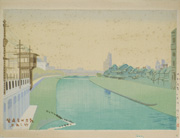
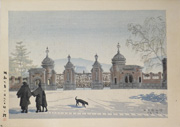
![View Inside [Kyōto] Gyoen](asano-takeji-1900-1999/Kyoto Gyoen National Garden ihl2373 thumb web.jpg)
